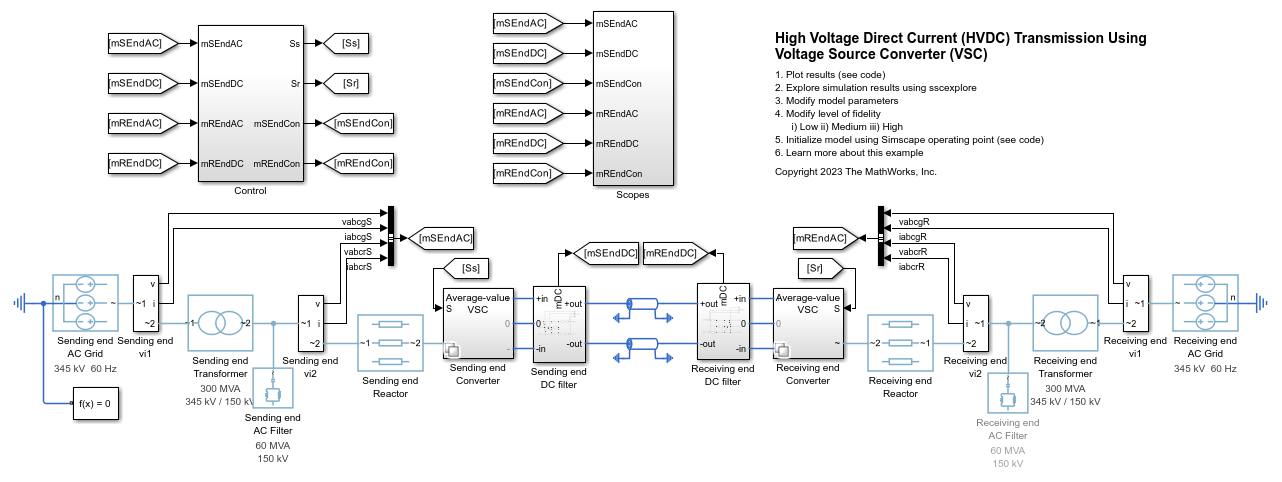High-Voltage, Direct-Current Transmission Using Voltage Source Converters
This example models a high-voltage, direct-current (HVDC) transmission system using voltage source converters (VSCs).
Model Overview
The VSC-HVDC transmission system comprises the power sending end, power receiving end, and DC transmission line. Each end includes the AC grid, voltage source converter, transformer, AC filter, smoothing reactor, and DC filters.
Initially, at the power sending end, the converter controls an active power of 0.5 p.u. (150 MW) to flow out from the AC grid. The converter also controls a reactive power of 0.1 p.u. (30 MVAr) to flow into the AC grid. At the power receiving end, the converter regulates the DC voltage at 1 p.u. (300 kV) and controls a reactive power of 0.1 p.u. (30 MVAr) to flow into the AC grid. At a simulation time of 2 s, the sending end increases the active power from 0.5 p.u. to 1 p.u. At a simulation time of 3 s, the sending end converter controls a reactive power of 0.1 p.u. (30 MVAr) to flow out from the AC grid at the sending end. At a simulation time of 4 s, the receiving end converter controls a reactive power of 0.2 p.u. (60 MVAr) to flow into the AC grid.

Model Different Levels of Details Using Variant Controls
Use the VoltageSourceConverterHVDCTransParameters script to create variant controls for the voltage source converter and converter controller. Specifically, the script defines these Simulink.Variant objects:
AverageValueVSCandSwitchingVSC. Use these objects with the average-value and switching voltage source converter.ControllerTimeModeandControllerFrequencyAndTimeMode. Use these objects with the time and frequency-and-time simulation mode.
This script also defines a fidelity variable that specifies the level of fidelity.
This example supports three different levels of fidelity:
Low - The example runs in frequency-and-time simulation mode. An average-value voltage source converter models the converter. The sampling time is equal to 1/60 s.
Medium - The example runs in time simulation mode. An average-value voltage source converter models the converter. The sampling time is equal to 66.67 us.
High - The example runs in time simulation mode. Ideal power electronic devices model the converter. The sampling time is equal to 6.667 us.
You can change the level of fidelity in the VoltageSourceConverterHVDCTransVariantControl script. This script configures the sampling time and simulation mode accordingly.
Initialize Model Using Simscape Operating Point
In this example, you create a Simscape™ OperatingPoint object from the logged simulation data and then use this operating point to initialize the model for a subsequent simulation run.
Use the VoltageSourceConverterHVDCTransInitializeModel script to perform these steps:
Configure the solver and control settings based on the fidelity level.
Simulate the model until it reaches a steady-state operation point at 1 second, then create an operating point from the logged simulation data.
Calculate the initial conditions used in the Control subsystem from the operating point.
Plot Simulation Results from Simscape Logging
These plots show the active and reactive power of the sending end and the DC voltage and reactive power of the receiving end.

See Also
Average-Value Voltage Source Converter (Three-Phase)